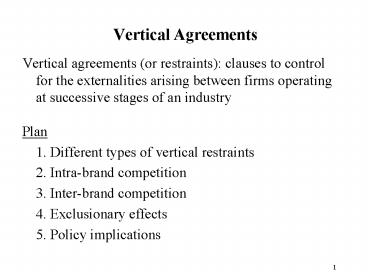Vertical Agreements - PowerPoint PPT Presentation
1 / 15
Title:
Vertical Agreements
Description:
Different vertical restraints are used (according to observability, absence of arbitrage etc. ... Whence, pi*(wi,wj), qi*(wi,wj). First stage: each Ui earns Fi wiqi. ... – PowerPoint PPT presentation
Number of Views:59
Avg rating:3.0/5.0
Title: Vertical Agreements
1
Vertical Agreements
- Vertical agreements (or restraints) clauses to
control for the externalities arising between
firms operating at successive stages of an
industry - Plan
- 1. Different types of vertical restraints
- 2. Intra-brand competition
- 3. Inter-brand competition
- 4. Exclusionary effects
- 5. Policy implications
2
1. Types of vertical restraints
- Different vertical restraints are used (according
to observability, absence of arbitrage etc.) - Franchise fee (FF) contracts
- Resale price maintenance (RPM)
- Quantity fixing
- Exclusivity clauses exclusive territories (ET),
exclusive dealing (ED), selective distribution - Tying
- Royalties
3
2. Intra-brand competition
- The problem of
- double marginalisation
- vertical integration (VI),
- RPM (ceiling), and
- FF efficient
- ET inefficient.
4
Intra-brand competition, II
- Interaction among
- retailers may create
- negative externalities
5
Intra-brand competition, III
- Free-riding among retailers and under-provision
of services VI, ET and RPM (floor) efficient - (N.B. Substitutability of vertical instruments)
- Quality certification RPM and selective
distribution - Free-riding among producers exclusivity clauses
- Exclusivity may also remove opportunistic
behaviour and promote specific investments
6
Intra-brand competition, IV
- Possible anti-competitive effects of vertical
restraints the commitment problem of an input
monopolist. - Example of commitment problem franchise
- Solution of the monopolists problem
- Vertical integration
- Exclusive territories
- Resale price maintenance
- Most-Favoured Nation clauses and
anti-discrimination laws (transparency is bad)
7
3. Inter-brand competition
- Illustration of
- inter-brand
- competition
8
Strategic use of vertical restraints
- Two upstream firms U1,U2 sell differentiated
goods. Demand is given by - Each upstream firm needs retailer (resp. R1,R2)
to sell the good - Zero production and retail cost, for simplicity
- It can be showed that vertical restraints
(delegation) can be used to increase profits
9
Integration v. delegation
- Vertical integration. If R1, R2 are owned by U1,
U2, one can find equilibrium by solving - From FOCs one obtains
10
VR Two-part tariffs
- 1st stage Ui sets Fiwiqi for Ri. Contracts are
observable. 2nd stage Ri chooses pi. - Last stage each Ri maxpipiR(pi-wi)qi (pi,pi).
Whence, pi(wi,wj), qi(wi,wj). - First stage each Ui earns Fiwiqi . Therefore,
Ui wants to maxwipiU(pi-wi)qiwiqi. - At equilibrium wigt0 and
11
Strategic effects of VR intuitions
12
Exclusive territories
- Rey and Stiglitz (1988) exclusive territories
allow manufacturers to relax competition. - Suppose each (differentiated) Ui has two or more
retailers perceived as homogenous by consumers.
Intra-brand competition piwi, and solution as
if Ui are vertically integrated. - Suppose now each retailer is given an ET. Then in
each territory, the game is as the one above, and
prices will be higher.
13
Inter-brand competition, III
- Vertical restraints might also facilitate
collusion - 1. Resale price maintenance
- 2. Common agency
14
4. Exclusionary effects
- Exclusive contracts and tying can be used as a
way to deter entry - (These will be analysed below, as they pertain
more to the abuse of dominance - art. 82 - than
to agreements - art. 81)
15
5. Policy implications
- Strong presumption VR enhance efficiency
- Possible anti-competitive effects only when
enough market power exists - Market power, not the type of agreement adopted,
matters - (gt change in the EC approach to VR)
- Large enough market power rule of reason,
balancing efficiency with (possible) adverse
effects































